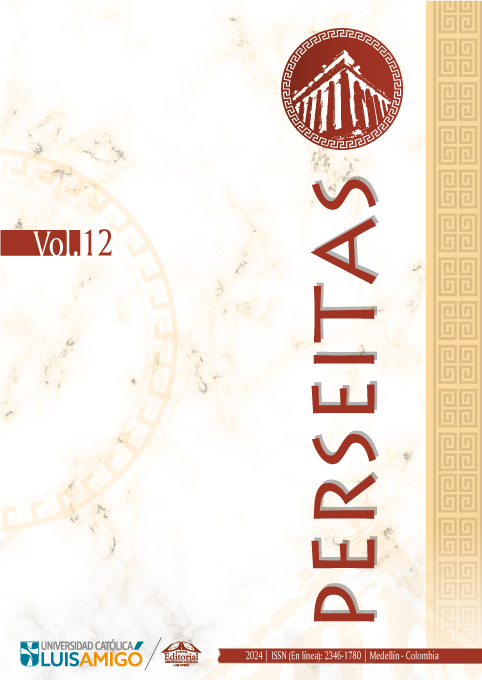An empathic ethic as a foundation for non-anthropomorphic aesthetic appreciation of animals
DOI:
https://doi.org/10.21501/23461780.4788Keywords:
Aesthetic, Animals, Anthropomorphism, Appreciation, Empathy, EthicAbstract
The main objective of this article is to analyze the bases of an aesthetic appreciation of animals in a non-anthropomorphic key that allows us to value animals in their own terms. Other appreciations have an anthropomorphic foundation, such as understanding animals from the artistic model or from our evolutionary needs. The context of this research is twofold: on the one hand, the dominant anthropomorphic attitude in modern culture, and, on the other hand, the new artistic and cultural initiatives far from the understanding of the human being as the center of all that exists. The methodology employed in this study is hermeneutic and dialectic. Hermeneutic because it aims above all to understand these new animalistic aesthetic manifestations, and dialectic because to understand them we establish a critical debate with the previous anthropocentric positions. The conclusion of the work is that the non-anthropomorphistic aesthetic appreciation of animals can only be based on an animalistic ethics. To achieve this, first, it is necessary to be aware of our anthropomorphic tendency. And, secondly, it is necessary to adopt an empathic ethic that allows us access to the point of view of animals, because only in this way will we be able to perceive them in themselves.
Downloads
References
Barrow, J. (2005). The Artful Universe Expanded. Oxford University Press.
Bekoff, M. (2024). The Emotional Lives of Animals. New World Library.
Bentham, J. (1970/1780). An Introduction to the Principles of Morales and Legislation. Athlone Press.
Berleant, A. (2004). The Aesthetics of Art and Nature. En A. Carlson y A. Berleant (Eds.), The Aesthetics of Natural Environments (pp. 76-88). Broadview Press.
Braidotti, R. (2013). Polity Press.
Brady, E. (2009). Aesthetic Appreciation of Expressive Qualities in Animals. Postgraduate Journal of Aesthetics, 6(3), 1-14.
Budd, M. (2002). The aesthetic Appreciation of Nature. Oxford University Press.
Carroll, N. (1993). On Being Moved by Nature: Between Religion and Natural History. En S. Kemal y I. Gaskell (Eds.), Landscape, Natural Beauty and the Arts (pp. 244-266). Cambridge University Press.
Carlson, A., & Berleant, A. (2004). Introduction: The Aesthetics of Nature. En A. Carlson y A. Berleant (Eds.), The Aesthetics of Natural Environments (pp. 1-42). Broadview Press.
Carlson, A. (1981). Nature, Aesthetic Judgment and Objectivity. The Journal of Aesthetics and Art Criticism, 40, 15-27.
Carlson, A. (2000). Aesthetics and the Environment. The appreciation of nature, art and architecture. Routledge.
Carlson, A. (2019/1979). Appreciation and the Natural Environment. En P. Lamarque y S. Olsen (Eds.), Aesthetics and the Philosophy of Art, The Analytic Tradition. An Anthology (pp. 665-672). Wiley-Blackwell.
Cavalieri, P. (Ed.). (2016). Philosophy and Politics of Animal Liberation. Palgrave MacMillan.
Clutton-Brock, J. (1999). A Natural History of Domesticated Mammals. Cambridge University Press.
Cortés Zulueta, C. (2019). Mirar a las aves mirar… y hacer (arte). Boletín de Arte-UMA, 40, 27-42. https://revistas.uma.es/index.php/boletin-de-arte/article/view/6642
Crawford, D. (2004). The Aesthetics of Nature and the Environment. En P. Kivy (Ed.), The Blackwell Guide to Aesthetics (pp. 306-324). Blackwell.
Darwin, Ch. (2016/1871). El origen del hombre (J. Domènech Ros, Trad.). Austral.
Davies, S. (2012). The Artful Species. Aesthetics, Art and Evolution. Oxford University Press.
Davies, S. (2018). Analyzing Human Adornment. The American Society for Aesthetics Newsletter, 38(2), 1-4. https://cdn.ymaws.com/aesthetics-online.org/resource/resmgr/newsletters/38.2.pdf
Dutton, D. (2003). Aesthetics and evolutionary Psychology. En J. Levinson (Ed.), The Oxford Handbook for Aesthetics (pp. 692-705). Oxford University Press.
Dutton, D. (2009). The Art Instinct. Bloomsbury Press.
Godlovitch, S. (1994). Icebreakers: Environmentalism and Natural Aesthetics. Journal of Applied Philosophy, 11(1), 15-30.
Gould, S. J. (1980). The Panda’s Thumb. More Reflections in Natural History. Norton.
Guthrie, D. (2005). The Nature of Paleolithic Art. University of Chicago Press.
Haraway, D. (2008). When Species Meet. University of Minnesota Press.
Hare, B., Brown M., Williamson, C., & Tomasello, M. (2002). The Domestication of Social Cognition in Dogs. Science, 298(5998), 1634-1636. https://doi.org/10.1126/science.1072702
Hepburn, R. (1966). Contemporary Aesthetics and the Neglect of Natural Beauty. En B. Williams y A. Montefiore (Eds.), British Analytical Philosophy (pp. 285-310). Routledge and Kegan Paul.
Herzog, H., & Burghardt, G. (1988). Attitudes toward Animals: Origins and Diversity. En A. Rowan (Ed.), Animals and People Sharing the World (pp. 75-94). University Press of New England.
Horta, O. (2017). Un paso adelante en defensa de los animales. Plaza y Valdés.
Kramnick, J. (2011). Against Literary Darwinism. Critical Inquiry, 37, 315-347.
Locke, J. (1980/1690). Second Treatise of Government. Hackett.
Low, P. (2012). The Cambridge Declaration on Consciousness. En J. Panksepp et al. (Eds.), Proceedings of the Francis Crick Memorial Conference (pp. 1-2). Churchill College, University of Cambridge.
Mandoki, K. (2007). Everyday aesthetics: prosaics, the play of culture and social identities. Ashgate.
Marchesini, R. (2018). Beyond Anthropocentrism. Thoughts for a Post-Human Philosophy. Mimesis.
Matthews, P. (2019). Scientific Knowledge and the Aesthetic Appreciation of Nature. En P. Lamarque y S. Olsen (Eds.), Aesthetics and the Philosophy of Art, The Analytic Tradition. An Anthology (pp. 673-683). Wiley-Blackwell.
Menninghaus, W. (2003). Das Versprechen der Schönheit. Suhrkamp.
Mitchell, W. T. (1995). Picture Theory: Essays on Verbal and Visual Representation.University of Chicago Press.
Miller, G. (2000). The Mating Mind: How Sexual Choice Shaped Human Nature. Anchor Books.
Nietzsche, F. (1981/1881). Aurora. Meditación sobre los prejuicios morales (P. González Blanco, Trad.). José de Olañeta Editor.
Nietzsche, F. (1980/1887). La genealogía de la moral (A. Sánchez Pascual, Trad.). Alianza.
O’Sullivan, S. (2015). Animals, Equality and Democracy. Palgrave MacMillan.
Parsons, G., & Carlson, A. (2008). Functional Beauty. Clarendon Press.
Parsons, G. (2007). The Aesthetic Value of Animals. Environmental Ethics, 27, 151-169.
Pepperell, R. (1995). The Post-Human Condition. Intellect.
Richter, K. (1999). Die Herkunft des Schönen: Grundzüge der evolutionären Ästhetik. Philipp von Zabern.
Rolston, H. (1987). Beauty and the Beast: Aesthetic Experience of Wildlife. En D. Decker y G. Goff (Eds.), Valuing Wildlife: Economic and Social Perspectives (pp. 187-196). Westview Press.
Rousseau, J-J. (1982/1754). Discurso sobre el origen y los fundamentos de la desigualdad entre los hombres (M. Armiño, Trad.). Alianza Editorial.
Rusow, L-M. (1981). Why Do Species Matter? Environmental Ethics, 3, 101-112.
Saito, Y. (2004). Appreciating Nature on Its Own Terms. En A. Carlson y A. Berleant (Eds.), The Aesthetics of Natural Environments (pp. 141-155). Broadview Press.
Singer, P. (2002/1975). Animal Liberation. HaperCollins.
Tafalla, M. (2017). The aesthetic appreciation of animals in zoological parks. Contemporary Aesthetics, 15. http://www.contempaesthetics.org/newvolume/pages/article.php?articleID=793 (consultado el 27 junio de 2023).
Tafalla, M. (2019). Estética, peletería y extinción de especies. El visón europeo como ejemplo. Azafea, 21, 103-127. https://revistas.usal.es/dos/index.php/0213-3563/article/view/azafea201921103127
Torres, M. (2022). Poder animal. Capacidades y derechos de los animales. Plaza y Valdés.
Wang, X., & Tedford, R. (2009). Dogs: Their Fossil Relatives and Evolutionary History. Columbia University Press.
Wolfgang W. (2004). Animal Aesthetics. Contemporary Aesthetics, 2. https://digitalcommons.risd.edu/liberalarts_contempaesthetics/vol2/iss1/15 consultado el 2 agosto de 2023).
Wittgenstein, L. (1988/1953). Investigaciones filosóficas (A. García Suárez y U. Moulines, Trads.). Crítica.
Wolloch, N. (2006). Subjugated Animals: Animals and Anthropocentrism in Early Modern European Culture. Prometheus Books.
Zangwill, N. (1995). The Metaphysics of Beauty. Cornell University Press.
Published
How to Cite
Issue
Section
License

This work is licensed under a Creative Commons Attribution-NonCommercial-NoDerivatives 4.0 International License.
La revista y los textos individuales que en esta se divulgan están protegidos por las leyes de copyright y por los términos y condiciones de la Licencia Creative Commons Atribución-No Comercial-Sin Derivar 4.0 Internacional.
















